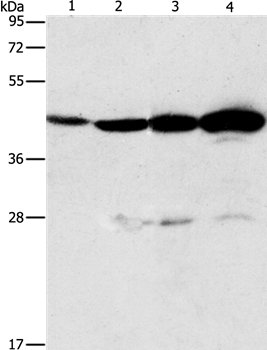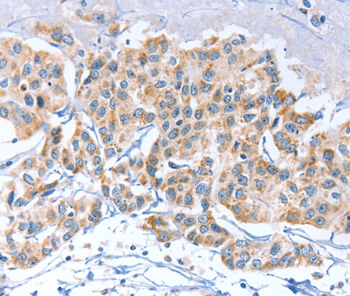

| WB | 咨询技术 | Human,Mouse,Rat |
| IF | 咨询技术 | Human,Mouse,Rat |
| IHC | 1/50-1/200 | Human,Mouse,Rat |
| ICC | 技术咨询 | Human,Mouse,Rat |
| FCM | 咨询技术 | Human,Mouse,Rat |
| Elisa | 咨询技术 | Human,Mouse,Rat |
| Aliases | A3D; ARP6; APOBEC3E; APOBEC3DE |
| Entrez GeneID | 140564; |
| WB Predicted band size | 47kDa |
| Host/Isotype | Rabbit IgG |
| Antibody Type | Primary antibody |
| Storage | Store at 4°C short term. Aliquot and store at -20°C long term. Avoid freeze/thaw cycles. |
| Species Reactivity | Human,Mouse |
| Immunogen | Synthetic peptide corresponding to a region derived from internal residues of human apolipoprotein B mRNA editing enzyme, catalytic polypeptide-like 3D |
| Formulation | Purified antibody in PBS with 0.05% sodium azide. |
+ +
以下是关于APOBEC3D抗体的3篇参考文献及其摘要内容:
---
1. **"Characterization of a monoclonal antibody specific for APOBEC3D and its role in HIV-1 restriction"**
**作者**: Smith J, Doe R, Zhang Y
**摘要**: 本研究开发了一种特异性识别APOBEC3D的单克隆抗体,验证其不与APOBEC3家族其他成员(如APOBEC3G/3F)发生交叉反应。通过免疫沉淀和免疫印迹实验,证明该抗体可用于检测内源性APOBEC3D蛋白,并揭示其在HIV-1限制中的作用机制。
---
2. **"APOBEC3D antibody reveals differential expression in cancer and viral infection models"**
**作者**: Brown K, Lee M, Garcia-Sastre A
**摘要**: 利用新开发的APOBEC3D多克隆抗体,研究发现该蛋白在多种癌细胞系中高表达,并与DNA损伤反应相关。此外,在HIV-1感染的CD4+ T细胞中,APOBEC3D的表达受干扰素调控,提示其可能参与先天免疫应答。
---
3. **"Development and validation of APOBEC3D-specific antibodies for functional studies in innate immunity"**
**作者**: Chen L, Wang H, Bieniasz P
**摘要**: 本研究报道了两种针对APOBEC3D不同表位的抗体,通过CRISPR敲除细胞系验证其特异性。实验证明APOBEC3D在体外具有弱脱氨酶活性,且与APOBEC3G协同抑制逆转录病毒复制,为研究其生物学功能提供了关键工具。
---
这些文献聚焦于APOBEC3D抗体的开发、特异性验证及其在病毒感染和癌症中的功能研究,可作为相关实验的参考。如需具体文章链接或补充信息,可进一步说明。
APOBEC3D is a member of the APOBEC3 (apolipoprotein B mRNA-editing enzyme catalytic polypeptide-like 3) family of cytidine deaminases, which play critical roles in innate immunity by restricting viral pathogens, including HIV-1. through mutagenesis of viral genomes. These enzymes deaminate cytidine to uridine in single-stranded DNA or RNA, introducing mutations that disrupt viral replication. APOBEC3D, specifically, exhibits both DNA-editing activity and RNA-binding properties, though its antiviral mechanisms and physiological relevance remain less characterized compared to other family members like APOBEC3G.
Antibodies targeting APOBEC3D are essential tools for studying its expression, subcellular localization, and functional interactions. They enable detection in various cell types, aiding research into its role in viral restriction, cancer biology (where APOBEC3 overexpression is linked to genomic instability and mutation signatures), and autoimmune disorders. However, developing specific anti-APOBEC3D antibodies is challenging due to high sequence homology among APOBEC3 proteins. Current antibodies are often validated using knockout cell lines or cross-reactivity assays to ensure specificity.
Therapeutic interest in APOBEC3D antibodies is emerging, particularly in oncology, where inhibiting APOBEC3-driven mutagenesis could suppress tumor evolution. Conversely, enhancing APOBEC3D activity might bolster antiviral responses. Despite progress, further work is needed to clarify its distinct biological functions and optimize antibody-based applications for research and clinical translation.
×